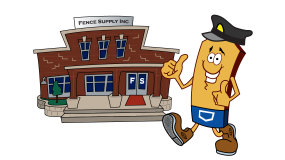Fence Components
Pickets
Pickets are available in a variety of widths and finishes; the most common is the 1” x 4” and the 1″ x 6”. Some of the available pickets are full-cut and others are a nominal. This can be very confusing if we don’t speak the same language. Fence Supply Inc. will always tell you if it is a 1″ x 6″ or 1″ x 5 ½” for the actual width.
Pickets are available with different shaped tops. Flat top, Dog Ear, Gothic point and Virginia or French Gothic are available from Fence Supply Inc.
Brackets
Fence Supply Inc. offers two styles of brackets for installing your fence on metal post: a one piece bracket and a two piece bracket. Both of these brackets use 4 lag screws per bracket. High quality ¼” x 1 ½” lag screws should be used.
Rails
Fence rails attach to the post with brackets, or in the case of a wood post, are nailed directly to the post. This is a very important component for a successful fence installation. The most common size for rails is 2” x 3” or 2” x 4”. Maximum post spacing is 8’ between posts; thus, a 2″ x 4″ x 8′ rail would be used. If you are doing an 8’ tall fence, we recommend using a 2″ x 4″ x 12′ rail and setting your posts on 6’ centers.
Posts
This is the foundation of the fence. If you’re on a tight budget this is not the area to try to save money. Invest in the best foundation you can afford. When you figure for your fence posts, remember depth and distance apart vs.fence height. All posts should be installed using our Sakrete product, which is available in 80 lb. bags for ease of loading and use. When building a 6′ high fence, you should set your posts at a depth of 2′ at a distance of 8′ on center (O/C). When building an 8′ high fence, you should set your posts at a depth of 2′ at a distance of 6′ O/C. (See gate section for gate post depths and measurements). Fence Supply Inc. recommends a minimum of 2-3/8″ posts for building wood fences.
Kick-board
Kick-boards are installed at the base of your fence. This is an excellent way to protect the bottom of your fence and/or add height to your fence as needed. Fence Supply Inc. recommends using 2″ x 6″ treated pine for your kick-board needs, although other sizes and types of wood are available. These 2″ x 6″ boards may be “stacked” to give more height as needed where there are low areas that need the extra height. Treated pine holds up well in all types of weather and maintains its integrity throughout its life. Fence Supply Inc. has the 2″ x 6″ treated pine available in 8′, 12′ and 16′ lengths.
Cap board
Installation of the cap board will add the finishing touch to your new fence. A cap board adds beauty to any wood fence and will set your fence apart from the others. When installing a cap board, ensure that your posts and the top of your upper rail are the same height as the top of your fence. This will give you the width and support necessary when attaching the cap board. Most cap boards will be either a 2″ x 6″ or a 2″ x 8″ and can be either cedar or treated pine, depending on your fence type.
Trim board
Trim boards are the crown molding for your new fence. The ultimate in beauty is the double step trim. There are several installation types to choose from; 1″ x 4″ x 8′ is the most common use of trim board; however, a 1″ x 2″ may also be used either as a single trim board or in combination with the 1″ x 4″ trim board to give a stair-step look to the trim. You should choose a trim board wood species that matches your fence type.
Screws vs. Nails
With today’s technological advancements in coatings, the choice of using screw vs. nails may be strictly a personal choice based on tools available or ease of installation. Either is an excellent choice and today’s coatings will give years of beauty without bleeding. Fence Supply Inc. recommends the Duo Fast coil or strip nails to be used in conjunction with the Duo Fast coil or strip nail guns which can help in decreasing your installation time. Battery-powered drills with Phillips bits may be used with our coated screws for a faster installation as well. Fence Supply Inc. carries all these products as well as galvanized hand nails for those wishing to install their fence in this manner. (See tool rental for tools available.)
Fence Gate Hardware
Wood gate hardware is offered to complement your new fence. Powder-coated black hardware is made for years of use. For walk gates we recommend using 3 hinges for both 6’ and 8’ tall fences.
Types of Wood Fence Styles
Side by Side – Traditional picket fences are sometimes referred to as a stockade fence. Pickets are placed side by side butted up next to each other. One misunderstanding is that space needs to be left between pickets. This is not true; the pickets when placed in this fashion will shrink and should be placed tight to maximize privacy.
Board on Board – This is a full privacy fence; you have two rows of pickets with the rear pickets spaced to allow a one inch overlap when the top board is installed. This style fence will give you maximum privacy.
Shadow Box – Pickets are placed behind and in front of each on opposite sides of the rails, creating an almost full privacy effect, but allows for air flow with this spacing.
Decorative Picket Fence – A traditional picket fence, commonly with 4’ tall by 8’ wide sections. The pickets will have a decorative point or top cut into the top edge of the picket. This fence is commonly used as a property board or decorative fence used in conjunction with a privacy fence.
Basket Weave – This a unique style of fencing consists of post and pickets only. The pickets are normally 1″ x 6″ x 16′ cedar or redwood and installed horizontally in a basket weave pattern.
Split Rail Fencing – Split rail is most commonly offered in a 2-rail and 3-rail option. This is a great farm & ranch, garden board, or accent fence. The hand-split style of components has a tremendous curb appeal to this style of fencing



